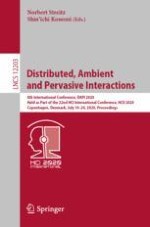This conference proceeding LNCS 12203 constitutes the refereed proceedings of the 12th International Conference on Cross-Cultural Design, CCD 2020, held as part of HCI International 2020 in Copenhagen, Denmark in July 2020.
The conference was held virtually due to the corona pandemic.
The total of 1439 papers and 238 posters included in the 40 HCII 2020 proceedings volumes was carefully reviewed and selected from 6326 submissions. The regular papers of DAPI 2020, Distributed, Ambient and Pervasive Interactions, presented in this volume were organized in topical sections named: Design Approaches, Methods and Tools, Smart Cities and Landscapes, Well-being, Learning and Culture in Intelligent Environments and much more.
